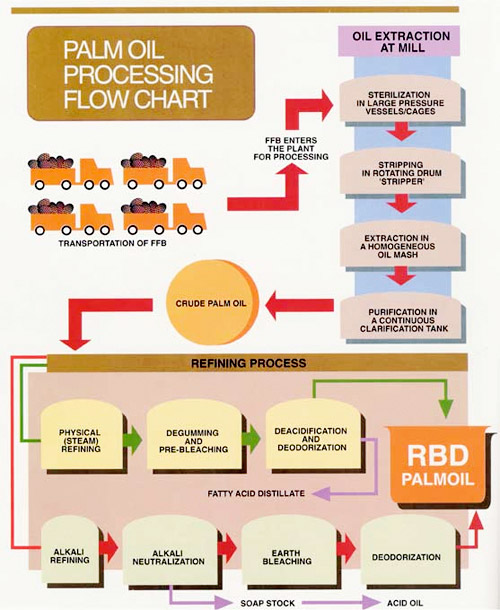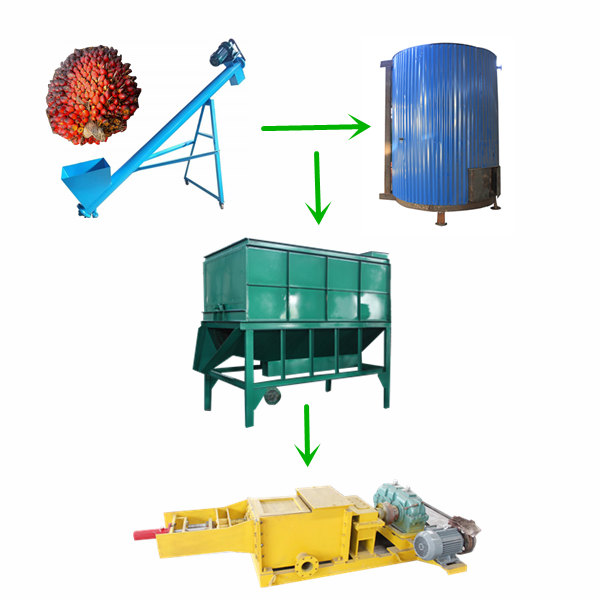Modern palm oil processing method
Industry news / Chat on line / Give me a price / Date: October 9, 2018
Modern processing of oil palm fruit bunches into edible oil is practiced using various methods which may be grouped into four categories according to their throughput and degree of complexity. These are the traditional methods, small-scale mechanical units, medium-scale mills and large industrial mills.
Generally, processing units handling up to 2 tones of fresh fruit bunches (FFB) per hour are considered to be small-scale. Installations that process between 2 and 8 tones FFB per hour are termed medium-scale, while large-scale redres to mills that process more that 10 tones per hour.
Palm oil processing flow chart:

Palm oil processing process
Much has been written about traditional palm oil processing technologies and medium- and large-scale palm oil mills, but information on small-scale palm oil processing units is scarce. The historical reason for the ready availability of information on medium- to large-scale operations and machinery is that most development work was undertaken in Europe, based on the observation of the traditional methods practiced in West Africa.
Machinery manufacturing is a recent development in the West Africa sub-region, and until recently it has not been possible to develop the sophisticated machines required to improve on traditional methods. Machinery manufacture in Africa must be carefully considered if progress is to be made in joining the rest of the industrialised world. Even now it is difficult to manufacture and sell bolts and coiled springs in the Central and West Africa sub-region. However, the manufacture of machines and combining them in the processing assemblies for small-scale rural industries is not within the scope of this publication. The main objective of this article is to provide a detailed description of the various processes involved in small-scale palm oil processing process, the tupe of machinery and equipment required, and their performance, energy and water consumption. The effect on the environment caused by waste and by-product uses is considered.
At the outset it must be stated that small-scale palm oil processing in the sub-region has systematically acquired sophistication, efficiency and reliability. It is agreed that traditional methods of extracting palm oil were inefficient and tedious for making oil for sale.
Generally women in the village are responsible for the processing and sale of fram produce. Small-scale agro-processing seems to hold the key to rural poverty reduction and the prolific oil palm tree provide the best raw material for starting rural industries.
Today small-scale processors who appreciate the value of using machines, are asking for them to be more sophisticated. Thus current demand for small-scale palm oil mills is shifting from simple stand-alone unit operational machines to a more integrated system which is easy to operate and maintain. Machinery manufacturers have responded with machines that combine several operations into one machine unit. The complete range of operation, oil drying and storage have been developed for small-scale processing applications. The processors can change and/or combine equipment to suit their purchasing power.
A by-product of palm oil extraction is the palm nut which, when cracked, yields a kernel containing a completely different kind of oil which can be used as a valuable substitute for cocoa butter. Unfortunately not many palm oil processors include palm kernel extraction at the same location. It is more usual that a completely different group undertakes palm kernel extraction.
To explain why this occurs, a description is included of how palm kernel oil is extracted and the relevant machinery and equipment needed, is indicated.
Henan Doing Machinery is a professional manufacturer of palm oil processing plant, we can supply you complete set palm oil processing plant with different capacities. Next i will introduce the small scale palm oil processing plant to you:
Modern palm oil processing methods introduce:
Before going into the technologies involved in the process of producing palm oil, we will talk about the processes involved. After harvesting the fruits in the oil plantation, the fruit bunches are moved to the palm oil mill. Here the fresh fruit bunches FFBs are weighed, and then the ffb will be transferred to the sterilization section where they are cooked. After sterilization the next step is stripping and threshing to separate the fruits from the husks or spent bunches (SFBs). The husks are then discarded and later used as fuel for firing the furnaces that power the sterilizer.The separated fruits are then transferred to the digester where the cooked fruits separated from the husks are mashed into a pulp. Hereafter the mash is transferred to the palm fruit oil pressing machine where the crude red palm oil is squeezed out and transferred into a clarifier for sedimentation.
The residue after digestion is a mixture of fiber and palm kernel nuts. This mixture is sent to a nut recovery system where the nuts are separated from the fiber. The nuts are dried and cracked to produce palm kernels.
The palm kernels are processed to produce palm kernel oil.
Modern small scale palm oil processing plant photos :

Main equipment in small scale palm oil processing plant
Generally, processing units handling up to 2 tones of fresh fruit bunches (FFB) per hour are considered to be small-scale. Installations that process between 2 and 8 tones FFB per hour are termed medium-scale, while large-scale redres to mills that process more that 10 tones per hour.
Palm oil processing flow chart:

Palm oil processing process
Machinery manufacturing is a recent development in the West Africa sub-region, and until recently it has not been possible to develop the sophisticated machines required to improve on traditional methods. Machinery manufacture in Africa must be carefully considered if progress is to be made in joining the rest of the industrialised world. Even now it is difficult to manufacture and sell bolts and coiled springs in the Central and West Africa sub-region. However, the manufacture of machines and combining them in the processing assemblies for small-scale rural industries is not within the scope of this publication. The main objective of this article is to provide a detailed description of the various processes involved in small-scale palm oil processing process, the tupe of machinery and equipment required, and their performance, energy and water consumption. The effect on the environment caused by waste and by-product uses is considered.
At the outset it must be stated that small-scale palm oil processing in the sub-region has systematically acquired sophistication, efficiency and reliability. It is agreed that traditional methods of extracting palm oil were inefficient and tedious for making oil for sale.
Generally women in the village are responsible for the processing and sale of fram produce. Small-scale agro-processing seems to hold the key to rural poverty reduction and the prolific oil palm tree provide the best raw material for starting rural industries.
Today small-scale processors who appreciate the value of using machines, are asking for them to be more sophisticated. Thus current demand for small-scale palm oil mills is shifting from simple stand-alone unit operational machines to a more integrated system which is easy to operate and maintain. Machinery manufacturers have responded with machines that combine several operations into one machine unit. The complete range of operation, oil drying and storage have been developed for small-scale processing applications. The processors can change and/or combine equipment to suit their purchasing power.
A by-product of palm oil extraction is the palm nut which, when cracked, yields a kernel containing a completely different kind of oil which can be used as a valuable substitute for cocoa butter. Unfortunately not many palm oil processors include palm kernel extraction at the same location. It is more usual that a completely different group undertakes palm kernel extraction.
To explain why this occurs, a description is included of how palm kernel oil is extracted and the relevant machinery and equipment needed, is indicated.
Henan Doing Machinery is a professional manufacturer of palm oil processing plant, we can supply you complete set palm oil processing plant with different capacities. Next i will introduce the small scale palm oil processing plant to you:
Modern palm oil processing methods introduce:
Before going into the technologies involved in the process of producing palm oil, we will talk about the processes involved. After harvesting the fruits in the oil plantation, the fruit bunches are moved to the palm oil mill. Here the fresh fruit bunches FFBs are weighed, and then the ffb will be transferred to the sterilization section where they are cooked. After sterilization the next step is stripping and threshing to separate the fruits from the husks or spent bunches (SFBs). The husks are then discarded and later used as fuel for firing the furnaces that power the sterilizer.The separated fruits are then transferred to the digester where the cooked fruits separated from the husks are mashed into a pulp. Hereafter the mash is transferred to the palm fruit oil pressing machine where the crude red palm oil is squeezed out and transferred into a clarifier for sedimentation.
The residue after digestion is a mixture of fiber and palm kernel nuts. This mixture is sent to a nut recovery system where the nuts are separated from the fiber. The nuts are dried and cracked to produce palm kernels.
The palm kernels are processed to produce palm kernel oil.
Modern small scale palm oil processing plant photos :

Main equipment in small scale palm oil processing plant
If you want to know more information about small scale palm oil processing plant, palm oil making machine, palm oil mill plant, palm oil refining machine, palm oil press machine, please Visit http://www.palmoilextractionmachine.com or contact us by phone 0086-37-56771823 or whatsapp 0086-13526627860 or email to palmoil@doingmachinery.com for further information!!!
Next:Origin of oil palm



